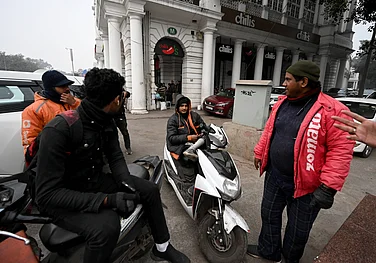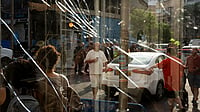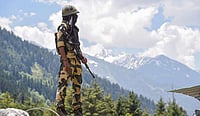Often we read articles by travel writers that fill us with envy and desire. "If only I could be there," we think wistfully as we read about the breathtaking beauty of the landscape, quaintness of the villages, the exotica of local culture. Im now convinced most travel writers just hype up the story, making the place seem more enchanting than it is. The whole effort seems designed to engineer envy. And, of course, to justify their trip.
A few months ago, I read an article in a European in-flight magazine about the lavender fields of Provence in the south of France. It mentioned that lavender fields are in full bloom from mid-July to mid-August, and, gushed the writer, "As we walk through the fields, we are seduced by the heady perfume and colour of the lavender fields." That seduced me enough to cut out the article and take it home. Especially because we had already planned a 10-day vacation in Provence in early August, and that, as the article said was the perfect lavender season. I have had my fill of seeing parthenium fields, so the prospect of seeing lavender in full bloom completely enchanted me.
We stayed in a tiny village in a 200-year-old French chateau surrounded by vineyards heavy with purple grapes. Using that as our base, we drove to all the beautiful spots of Provence. There was plenty to feast upon, but I was restless to see the lavender fields. The author of the article had specifically described the rows of lavender fields surrounding the 12th century Abbey Notre Dame de Senanque. So that was our first destination. It is an hours drive away but we couldnt make it on the first day because it closes at 5 in the evening. We decided to take the trip next day after lunch. We set off armed with road maps and two highly recommended glossy guide books. Its a beautiful drive through the hills and dales of typical French countryside. At every turn, I anticipate purple fragrance. But the fields are gold with sunflowers, not purple with lavender. We soon realise weve taken the wrong road. Its all my fault of course. Id been too busy gazing at the landscape and not the map on my lap. When we eventually find the right road, its too late. Theres no way we can reach the abbey till 5.30. So we instead head for Fontaine de Vaucluse, which is the source of the river Sorgue. The place is absolutely magnifique, as the French would say.
The rivers source is a small circular pool located in a cave, literally in the bowels of a brooding, craggy mountain. The pools water trickles into a subterranean river, hidden from view by a mound of boulders. It gurgles to the surface some 100 meters away, swelling into a little meandering brook fringed by tall granite cliffs, atop which is a ruined castle. The water is so crystal clear you can see the veins on the leaves of the underwater foliage. The air is just as pure. Theres something truly magical about the golden sunshine of Provence. You begin to understand why it lured famous painters like Van Gogh, Picasso, Matisse and Renoir.
On the third day, we left early to allow for wrong turns and detours. We decided to take a new route to the Abbey - its always more interesting to discover new territory than cover the same ground twice. Along this new road, we saw signs pointing to "Grottes de Thouzon", the cave of stalactites, something we didnt know about because neither of the two guide books mention it. Ive never seen stalactites, so I was excited and insisted on making the detour. As wed left early, we had plenty of time to make it to the abbey before it closed. So we branch off from the main road into apple orchards. The landscape is flat except for one solitary limestone hill in the distance beneath which lies the cave of stalactites. The cave leads to a 230-meter-long underground gallery with some of natures most spectacular artwork. Long, slim graceful stalactites in brilliant orange hanging from the roof, rounder gray-coloured stalagmites rising from the earth as if reaching out to their partners above. The cave is 60 million years old. The beauty of the stalactites is breathtaking and humbling, proof that no human artistic endeavour can match natures. Its not merely a matter of creativity, it highlights the virtue of patience. It takes nature 6,000 years to create a meter of stalactite, drop by drop, ever so slowly that youre cross-eyed with impatience just waiting to watch the drop fall.
Im silent with wonder as we resume our journey to the Abbey. Soon I feel a creeping sense of excitement. Any moment now we will be hit by the sight and smell of lavender. We turn a mountain corner and the Abbey, nestling below in a valley, comes into view. But not a single lavender is in sight. The fields are green, not purple. The travel-writer had got it all wrong. It turns out the lavender is in full bloom in June and in July it is harvested to make oils, essences, soaps and perfumes. By August, purple fragrance is but a memory of the senses. What a mighty letdown!
So we changed course and instead visited Roussillon, a spectacular hilltop village with all its buildings in shades of red. The hues, which seem to be the product of an artists brush, come from more than a dozen shades of ochre discovered in and around the village. Amidst the surrounding green hills are cliffs of blood - big, broad gashes of red that are in fact ochre deposits. We had a delicious, aromatic Provenal meal in an enchanting little red, open-air restaurant, under a canopy of red, purple and pink flowers and vines drooping with bunches of green grapes. The magic of Roussillon compensated for the lavender fiasco.
As with travel so in life, destinations are often not what theyre purported to be. But so much joy and unexpected pleasures can be derived from the journey itself, provided you have an open, optimistic and flexible mind. The longer you live, the greater is the realisation that satisfaction and pleasure often come more from the detours of life, than from the achievement of ones goals.
(The author can be contacted at anitapratap@usa.net)


























